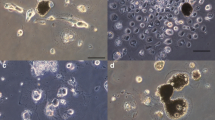Summary
A procedure has been developed for the accurate, quick, and simple indexing of the growth of insect cell monolayers with a reticule in the eyepiece of an inverted phasecontrast microscope. A magnification of ×500 is desirable for accuracy and ease of counting. Cell nuclei whose circumferences include any of the 25 points in the reticule are enumerated in each microscopic field. Counts of as few as five fields gave an error of 18.8% per flask. Ten fields gave an error of 11.5% and provided a sufficiently accurate comparison for many purposes. Forty counts allowed the measurement of differences between treatments with an error of 5.85%. A large number of treatments can be handled simultaneously, due to the small number of replicates necessary and the small amount of time required per treatment. When the capacity of different batches of lactalbumin hydrolysate to support growth was tested in our insect tissue culture medium, some of them were found to be suitable and others unsuitable. Doubling time of cell populations was measured, after the ratio of the average area of the nuclei at time 0 to that at timeX was used to multiply the number of nuclei counted at timeX. Average nuclear areas were satisfactorily measured by simple measurements of nuclear diameter on an ocular micrometer. The cell nuclei tended to decrease in area when cell monolayers reached confluence or became crowded. The number of replicates required was reduced, because the same flask could be used several times without disturbing the cell monolayer. The method of counting nuclei in a monolayer by means of reticule points and a phase-contrast microscope can also be adapted to the estimation of the absolute number of cells growing on the bottom of a flask.
Similar content being viewed by others
References
Paul, J. 1970.Cell and Tissue Culture, 4th ed. The Williams & Wilkins Co., Baltimore, pp. 280–284.
Jamieson, C. W., D. Russin, E. Benes, C. W. De Witt, and J. H. Wallace. 1969. Growth inhibitory effect of non-immune lymphocytes on tumour cells, in vitro, in the absence of mitogenic agents. Nature (London) 222: 284–285.
Mitsuhashi, J., T. D. C. Grace, and D. F. Waterhouse. 1970. Effects of insecticides on cultures of insect cells. Entomol. Exp. Appl. 13: 327–341.
Castor, L. N. 1971. Control of division by cell contact and serum concentration in cultures of 3T3 cells. Exp. Cell Res. 68: 17–24.
Froeze, G. 1971. Regulation of growth in Chinese hamster cells by a local inhibitor. Exp. Cell Res. 65: 297–306.
Gerschenson, L. E., T. Okigaki, M. Anderson, J. Molson, and M. B. Davidson. 1972. Fine structural and growth characteristics of cultured rat liver cells. Insulin effects. Exp. Cell Res. 71: 49–58.
Martinez-Lopez, G., and L. M. Black. 1972. Improvements in a culture medium for the growth of agallian leafhopper cell monolayers (abstr.). Phytopathology 62: 776–777.
Chiu, R. J., and L. M. Black. 1967. Monolayer cultures of insect cell lines and their inoculation with a plant virus. Nature (London) 215: 1076–1087.
Rinaldini, L. M. 1959. An improved method for the isolation and quantiative cultivation of embryonic cells. Exp. Cell Res. 16: 477–505.
Snedecor, G. W., and W. G. Cochran. 1967.Statistical Methods, 6th ed. The Iowa State University Press, Ames, p. 58.
Black, L. M. 1969. Insect tissue cultures as tools in plant virus research. Annu. Rev. Phytopathol. 7: 73–100.
Martinez-Lopez, G., and L. M. Black. 1971. The application of an electronic cell counter to the study of growth of insect cell monolayers (abstr.). Phytopathology 61: 902.
Martinez-Lopez, G. 1971. The application of an electronic cell counter to the study of growth of insect cell monolayers. M.S. thesis, University of Illinois.
Author information
Authors and Affiliations
Additional information
Portion of a thesis by the senior author submitted for the Ph.D. degree to the Graduate College of the University of Illinois. This research was supported in part by grant GB 20915 from the National Science Foundation and United States Public Health Service grant AI 6392 from the National Institutes of Health.
Rights and permissions
About this article
Cite this article
Martinez-Lopez, G., Black, L.M. A simple and accurate method for the measurement of the growth of cell monolayers. In Vitro 9, 1–7 (1973). https://doi.org/10.1007/BF02615981
Issue Date:
DOI: https://doi.org/10.1007/BF02615981



